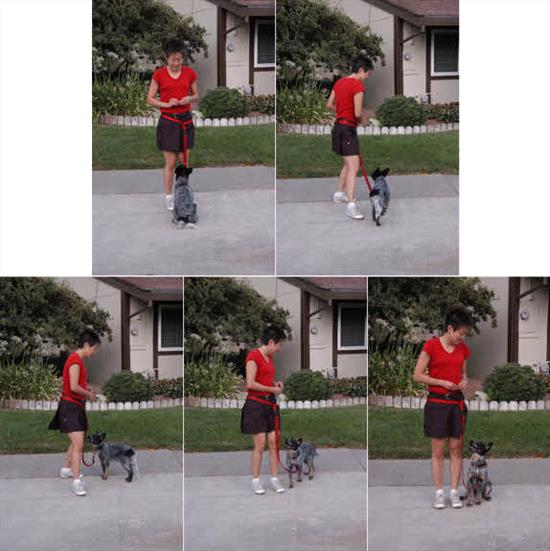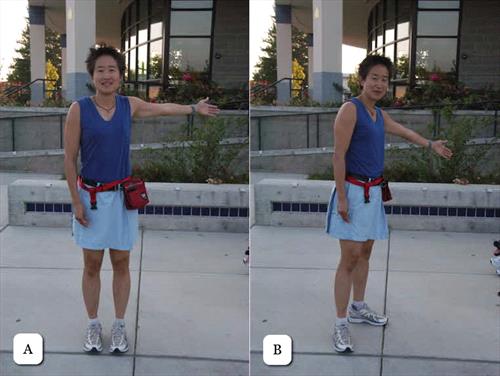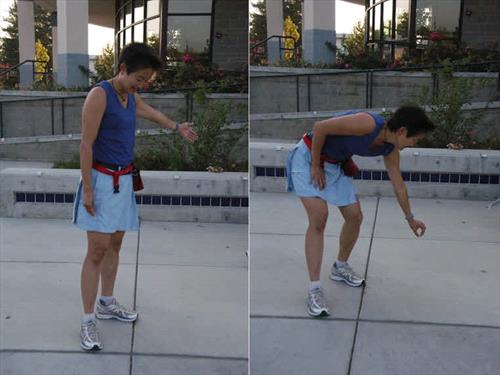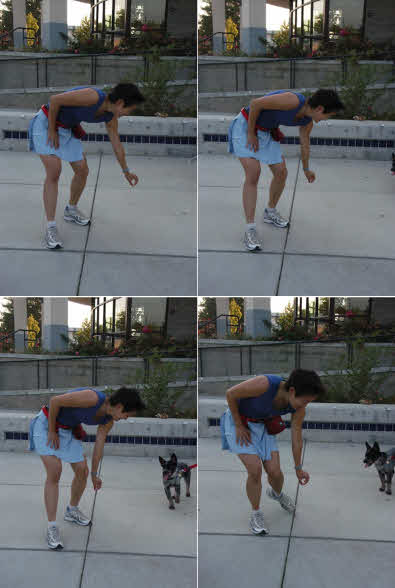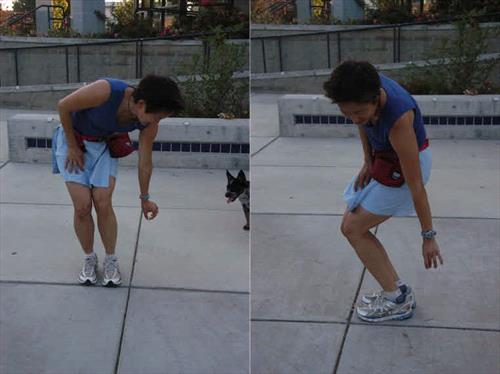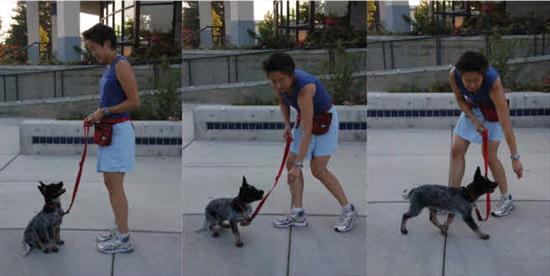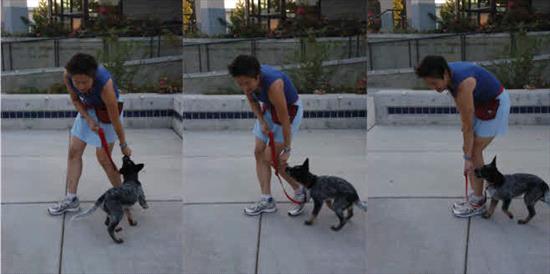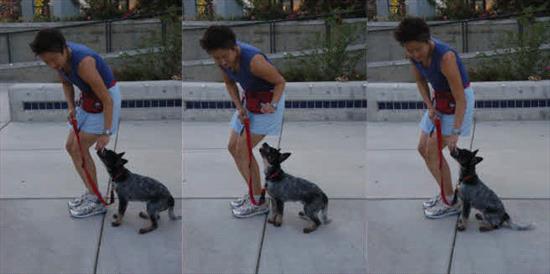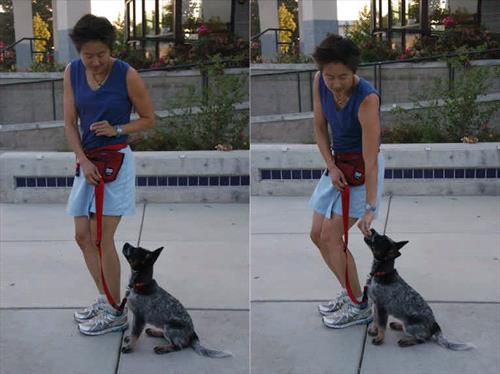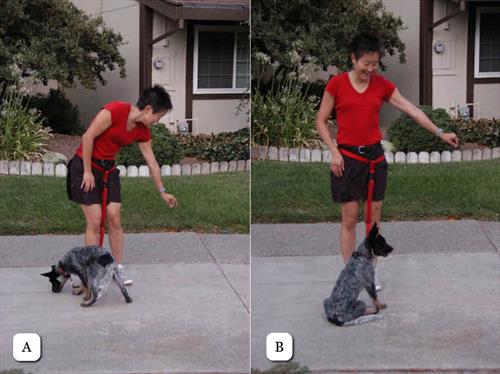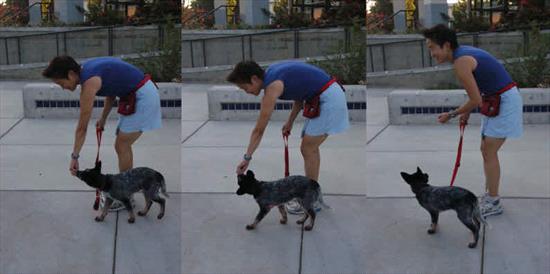Frequently, when you want to start your walk, or at other times, you need to get your dog back to your side. Here is quick and simple way to teach it.
In this exercise, ultimately you will be able to just say “heel” or position your shoulders the correct way and your dog will go back to your left side (or right side if she heels on the right side). For instance, Lucy, the dog pictured below, knows that if I step back with my left leg and turn my left shoulder away from her she should go back to heel position and sit. I don’t even have to say “heel.”
First practice without the dog.
This exercise is pretty easy for dogs once the humans can give the right movement and position cues. So, first practice without the dog: When getting the dog to walk from in front of you to past your left side so that they can turn around to sit in heel position, it’s important how you move your body. You want to think about moving in a way that welcomes him to walk past you. For instance, imagine if you were trying to signal to a person that he should walk past you into a room.
Image A: INCORRECT: In this case, my body is facing forwards and my arm is randomly out to the side. This language means nothing to a dog or a human.
Image B: In this case, I’ve moved my left leg back, turned my body to the left and extended my arm out in a way that welcomes the dog (or a person) to head in the direction of my arm.
Now, to make this movement have meaning to your dog, hold a treat in your left (welcoming) hand. You’ll use the treat to lure Fido into position. Take a step backwards with your left leg while keeping your right leg stationary.
Simultaneously, reach back with your left hand to the location where you want your dog to run. Make sure you place the treat low enough—at her chin level.
The hand also needs to be far back enough so that, once the dog gets to it, she has room to turn around. Once you have it in place, guide the treat towards you like you’re stirring a pot. Once the treat is next to your left leg, step forward with the left leg while keeping the treat slightly behind your leg.
When your feet are close together, your hand should be slightly behind you so that the dog stops slightly behind you on your heel side. Once your dog has come to a complete stop, you can raise the treat so he sits.
This seems simple, but you should probably practice it in stages.
Step 1: Just practice by starting in your netural position with arms bent 90 degrees with your hands centered and at your belly button. Then practice keeping the right foot stationary while stepping back with your left. Simultaneously place the treat down low where you want the dog to go. Then stop the exercise and go back to the starting position. Repeat this 5 times or more and then go to step 2.
Step 2: Repeat step 1 but this time, once you get the treat in position, arc it the way you will when you use it to lure your dog to turn around. Then as you step your left leg back next to your right leg, let your arm follow your leg and stop just behind it. Practice this 5 or more times until you can do it without needing to think.
Step 3: Repeat Step 2, but this time, after your feet come together and your treat hand stops right behind and to the side of your left leg, raise the treat like you would in order to get your dog to sit. Then practice delivering 1–3 sequential treats. Again, repeat this step about 5 times or until you feel comfortable.
Now try it with your dog.
Start with the dog sitting in front of you. Step back with your left leg while keeping your right leg planted the entire time. Place the treat where you want her to go. Once she reaches the treat, don’t give it to her yet. Use it to lure her to turn around and face forward. Note that she must turn around towards you because if she turns around looking away from you, you are likely to lose her attention. Once she’s turned around, step forward with your left leg while keeping the treat down at her chin level.
Note that my hand is still behind my leg because I want Lucy to stop a little bit behind me rather than forging ahead. Once I have her where I want, I lift the treat until she sits. Then when she sits, I give it to her. So, overall, she only gets the treat when she’s in position and sitting.
Side View: Here’s the same thing from another view.
Note that I place the food lure farther back than my left leg.
Once she reaches the treat, I use the treat to guide her to turn around and then step forward with my left leg so that it’s even with my right. Note that the treat is still behind my leg such that Lucy stops a little behind me.
Once she’s stopped, I raise the treat until she sits and then reward her once she sits.
Reward your dog with 1–3 sequential treats for remaining seated so she learns to remain seated instead of getting up immediately. Once she gets the idea, you can switch to a variable schedule of reinforcement where sometimes she gets one treat for going back to heel position, sometimes she gets several sequential treats, and other times she gets no treats. Her ultimate reward is that she gets to walk forward.
Avoid These Mistakes:
This exercise looks pretty straightforward, but here are few common mistakes you’ll want to be sure to avoid.
Image A: Incorrect: Dog not looking. Dog must see the treat and body movement/arms sign in order to respond.
Image B: Incorrect: The lure is held too high. The dog can’t see it.
Incorrect: In this case, I’ve held the treat too far in front of me once I get the puppy back near heel position. As a result, Lucy doesn’t stop next to my side and instead stops ahead of me.
When To Add the Cue Word and Remove the Lure
After you’ve practice the exercise 10–15 times, your dog should be pretty good at getting back into heel position. He should be consistently following the lure into place. Now you can start using the cue word “heel,” stated in a positive tone, right before you lure him and move your body. The word will come to predict that you are about to lure him. After 5–10 repetitions, try it without the food lure. But make sure you’re still using then your body position cues. If Fido responds well to your shoulder and body movement (minus the arms and food lure), then you don’t need to use the lure anymore. After you practice without the lure another 5–10 times, try it with just the verbal cue to see if Fido knows it without the visual body movements. If not, that’s ok you can just continue using the body movement or give just enough movement for her to get the idea. After you continue practicing regularly, she’ll pick up that “heel” means to get back by your side. Alternatively, you don’t really need the verbal cue. You can choose to just use the visual body signal.


